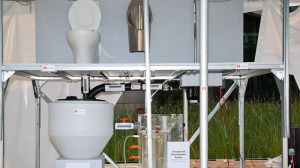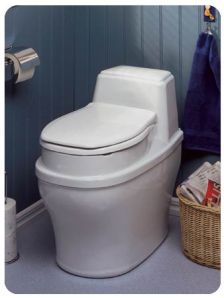I’ve written before about the number of people in the world who lack basic toilet facilities. There are plenty of campaigns to fix that, most of them making very slow progress – at this rate it will be 200 years before water and sanitation extends across the whole of Africa. We’ll get there eventually, but when we do, it probably won’t be with what we currently recognise as a toilet.
I suspect that what you have in your bathroom is the same thing as I have in mine – a white porcelain bowl that flushes out through a pipe and away to the sewer. It’s a classic technology that’s been around in Britain since the Victorian era. The richest households had indoor flushing toilets first of course, but by the 1950s almost everyone had one.
A toilet may be simple device at the household end, but it requires an enormous amount of infrastructure, from piping, to sewers, to sewage treatment plants. It also needs a large amount of clean water for flushing, a highly inefficient system in places where water is scarce. They’re hugely expensive, and very wasteful.
So last year, the Bill and Melinda Gates Foundation set up a challenge to ‘reinvent the toilet’. This toilet of the future had to be affordable, and that means it has to be ‘off-grid’. It has to function without piped in water or sewerage, and without an external power source. It’s not just an attempt to find a low cost solution for developing countries though. The Foundation is looking for “an aspirational product that leapfrogs flush toilets”, in the words of Frank Rijsberman, “a product that all of us would want to use.”
 It’s a great idea, and last week the winners were announced. Here’s the winning idea from the California Institute of Technology. As you can see from the picture on the right, the toilet itself is perched above that big white cistern, which is actually a solar-powered electro-chemical reactor. It breaks down water and waste to create hydrogen, which can then be stored in hydrogen fuel cells and …
It’s a great idea, and last week the winners were announced. Here’s the winning idea from the California Institute of Technology. As you can see from the picture on the right, the toilet itself is perched above that big white cistern, which is actually a solar-powered electro-chemical reactor. It breaks down water and waste to create hydrogen, which can then be stored in hydrogen fuel cells and …
Hang on a second, wasn’t this intended for the 2.5 billion people who haven’t got a toilet? Can you see this being fitted in Kibera? Hydrogen fuel cells aren’t exactly available from the street corner kiosk.
Looks like the Gates Foundation has forgotten what it was trying to do. As well as the expense and the sophistication, the winning design hasn’t even re-thought the basic flaw with the flushing toilet. It still uses a water flush, and all the innovation comes in how the water is processed. As Lloyd Alter at Treehugger writes, “this toilet isn’t dealing with waste, it is dealing with the medium that is moving the waste, the flushing water”. The second place entry from Loughborough University is only marginally better, based as it is on ‘hydrothermal carbonisation‘. Amazing technologies for sure, but not on brief.
So this is, sadly, the Foundation has not created a toilet for the 21st century. Not for most of us, anyway. The toilet of the future is still out there, waiting to be discovered. Actually, it probably exists already. Permaculturists get very excited about them – the composting toilet.
 In nature, there’s no such thing as waste. Everything gets recycled, new life from old. The toilet of the future needs to recognise that human effluent is not toxic waste that has to be swept away and buried forever. Treated right, it can be a resource, returning nutrients to the soil. It is entirely possible to treat waste at home, using natural decomposition processes. Modern composting toilets simply optimize the temperature and moisture content. They operate without water, chemicals, drains or a septic tank. If you’re still imagining a hole in the ground, here’s one on the left – you can buy it here.
In nature, there’s no such thing as waste. Everything gets recycled, new life from old. The toilet of the future needs to recognise that human effluent is not toxic waste that has to be swept away and buried forever. Treated right, it can be a resource, returning nutrients to the soil. It is entirely possible to treat waste at home, using natural decomposition processes. Modern composting toilets simply optimize the temperature and moisture content. They operate without water, chemicals, drains or a septic tank. If you’re still imagining a hole in the ground, here’s one on the left – you can buy it here.
The most sophisticated composting toilets use a small amount of electricity for ventilation, mixing and so on. You can make them without electricity too, they just work a little slower.
For developing countries, the best solution might be dehydrating toilets rather than composting toilets. These use air-flow to evaporate the water content from waste, reducing its bulk by about 90% and producing a dry and safe compost at the end of it.
At the moment, waterless toilets are considered the province of organic gardeners and hippies, but there’s no reason why they shouldn’t be for everyone. There are fortunes to be made creating businesses that install, maintain and empty them, collecting the inert compost for re-sale.
Every species creates waste in its own way. We humans have developed a fiendishly overcomplicated and unsustainable way of dealing with ours. That will change, and the toilet of the future will be low tech. If Bill Gates were a permaculturist and not a techy, he’d know this already.

There’s a whole lot of money to be lost as well, especially if you are working the current system, which is why the rules all back that way of working. Here in Germany the rules dictate a flush toilet, probably because sewage is an income stream (sorry) for the local towns who charge by the cubic metre.
On the other hand of course, there’s no rule to say we must use the flush toilet…
It’s strange how often the rules hold back progress, even though you can understand why they passed that law in the first place. Interesting that you have metered sewage charges though. We have a flat fee here, so I would pay the same even if I didn’t use the flush toilet.
I came across the Ventilation Improved Pit (VIP) toilet this summer when a camp my children attended raised some money for them in part of Africa:
Click to access EcologicalToilets-PeterMorgan-Mar2009.pdf
Some neat ideas in that pdf – thanks for sharing. I like the idea of digging smaller pits and then planting a tree on top.
Off-mains toilets are commonplace in Sweden. The main thing is to have good ventilation to the collecting tank and take care about what goes into it ie no disinfectants etc. The contents is emptied composted.
Yes, all the most advanced versions of composting toilets seem to be from Sweden. It’s technology we should be learning from, definitely.
The winner of the challenge? Caltech, which took home a $100,000 prize. Led by professor Michael Hoffman, the Caltech toilet runs on solar power, and breaks waste down into power-generating hydrogen.
Nice post. We were thinking the same when we saw the results. How can afford such a fancy thing?
What I’d like to know: are there any good ideas about how to make a (compost or other) toilet in wetland areas? (We’re living in the Amazon.)